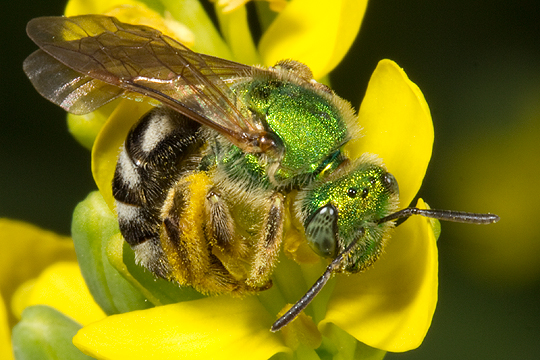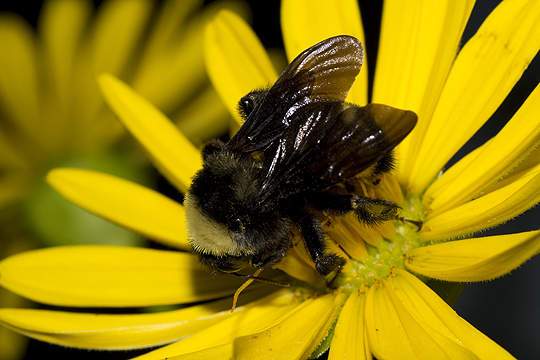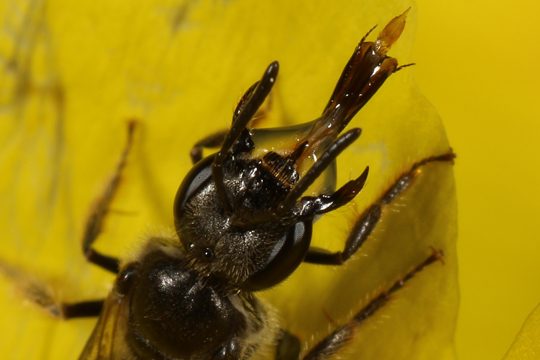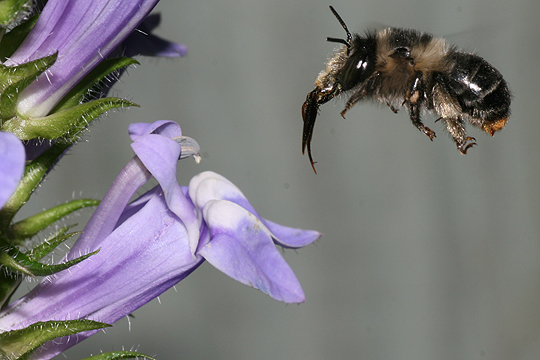There are hundreds of different bees that could visit your garden and they are the most important group of pollinators in Canada and N.E. USA. They are therefore valuable for both economic and ecological reasons. Unfortunately, many species are declining in numbers and range. You can help bees by providing plants with nectar and pollen as well as appropriate nesting sites. Do not worry about the demise of the honey bee (which is not native) if you are growing vegetables. Many native bees work harder than honey bees and for longer hours. Please check out the recommended bee plants or gardening for bumblebees for a more detailed listing.
| |
 |
|
| |
Agapostemon virescens is a common and important pollinator of flowers |
|
Typically, only long-tongued bees or very small bees can access the nectar in tubular flowers while more open flowers support both short and long-tongued bees. Open flowers therefore encourage high bee densities. Flowers that are attractive to bees tend to produce concentrated hexose-rich nectar. While there are some very good nectar plants from exotic places, native plants support more diversity and are preferred in gardens for pollinators.
| |
 |
|
| |
Bombus pensylvanicus, the American bumblebee, used to be a common in Ontario 30 years ago, but now it is quite rare and is listed as a species of special concern in Ontario. |
|
Bees tend to forage on the same type of plant on a particular trip so you have to plant in patches that are a minimum of 3 or 4 feet in diameter or distribute several specimens of a particular species throughout your garden to make a plant worth visiting. Bees may have to travel a fair distance to get to their source of pollen or nectar, so it is not efficient for them to make this trip to access a single plant.
| |
 |
|
| |
This Lassioglossum is regurgitating the nectar. Each time it does this, water evaporates out of the solution which lightens the load and makes the trip home more efficient. |
|
Avoid flowers that are genetically modified from the original native plant as they tend to produce less pollen and nectar. In particular, double-flowers are ineffective in pollinator gardens. Also, check that your garden store is selling plants that are not grown from seed treated with neonicotinoids. These chemicals are really harmful to all bees and in recent years have been used excessively in the horticultural sector.
| |
 |
|
| |
Anthophora sp. have long tongues that can reach down into these great blue Lobelia flowers. In this picture, the glossa is clearly seen to be sticking out beyond the other mouthparts. The sheaths that surround the glossa are called the labial palps and it is the length of these structures that determines whether a bee is considered to be long-tongued or not. |
|
Most of the plants shown bloom from July onwards. While there are certain bees that are active in spring, there are more bees looking for nectar later on in the growing season than in the spring so your bee garden ought to become more floriferous as the summer progresses. Bees active in spring can be supported by planting trees that flower early in the season and some early season perennials. The plants listed below encourage high bee densities in gardens. Lots of flowers have been excluded because they are not suitable for gardens, not easily available, not native or only support a limited number of specialist bees. The pictures below are arranged according to when they start blooming.



